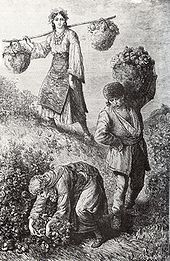Rose Valley (Bulgaria)

The Rose Valley or the Valley of Roses ( Bulgarian Розова долина Rosowa dolina ; scientific transcription. Rozova dolina ) is an area in Central Bulgaria , east of 200 km Sofia area.
The Rose Valley is known for the open-air cultivation of white, pink and red roses, which grow there in fields that are kilometers long for industrial purposes. There, in the sheltered valley between the two mountain ranges running in east-west direction, the summer-blooming Damascus roses ( Rosa damascena ) have been grown for centuries , mainly the Trigintipetala variety , synonymous with Kazanlak , which is mentioned as "Bulgarian oil rose" as early as 1689. The precious rose oil , one of the most expensive essential oils, is obtained from the petals of this rose by means of distillation . Rose oil is widely used in perfumery , in the perfuming of food and luxury goods, and in pharmacy.
location

The Rosental runs in an east-west direction. The valley is relatively wide, almost a plain, which is only bordered by mountains in the north and south - in the north by the central Balkan Mountains and in the south by the eastern part of the Sredna Gora mountain range . Geologically speaking, the Rose Valley consists of two river valleys - the Strjama river valley in the west and the valley with the Tundscha river in the east . The western part of the Rose Valley is also known as the Karlovo valley basin (Bulgarian Карловска котловина) and is named after the town of Karlovo ( location ). The eastern part of the Rose Valley is called the Kazanlak Basin (Bulgarian Казанлъшкото поле, literally Kazanlak Field ), after the nearby town of Kazanlak ( Lage ).
There are also some Thracian burial mounds in the Rose Valley .
economy
In the 17th century rose cultivation expanded from Persia to India, North Africa and Turkey. In 1710 rose growing began in Bulgaria, in Kazanlak. From 1750 to the present day, the region between Kazanlak and Karlowo is the most important growing region for the production of rose oil. At the beginning of the 20th century there were still around 2800 small distillers for rose oil in Bulgaria with steam tanks for around one to ten tons of flowers.
Bulgaria is the world's largest producer of rose oil, it provides 70% of the world's rose oil production. The roses for this are mainly grown in the Rose Valley. The petals are harvested very early in the morning, when the oil content in them is greatest. About one liter of rose oil is distilled from three tons of flowers. This corresponds to a yield of only 0.02 to 0.05%. Bulgaria produced around 900 kg of rose oil in 2003. The center of the rose oil industry is Kazanlak, other smaller centers are Karlowo, Sopot and Kalofer .
The season for picking the rose petals runs from May to June. During this time the whole valley smells of roses and is covered with roses. Picking the roses is traditionally a task for women, which requires a lot of skill and perseverance. The flowers are carefully cut off individually, placed in wicker baskets and transported to the distillery. After the end of the picking season in June, flower celebrations and folklore festivals are celebrated in the villages and towns. Every year a festival of roses and rose oil is held in the Rosental.
In addition to growing roses, viticulture is also practiced in the Rosental . The geographical origin "Rosentaler Kadarka " is named after the Rosental.
people
Some revolutionaries of the Bulgarian Revival grew up in the Rose Valley :
- Wassil Lewski (born in Karlovo)
- Christo Botew (born in Kalofer)
- Ivan Wasov (born in Sopot)
Others
The Rosental has given its name to the Rosental Glacier on Livingston Island in Antarctica since 2005 .

